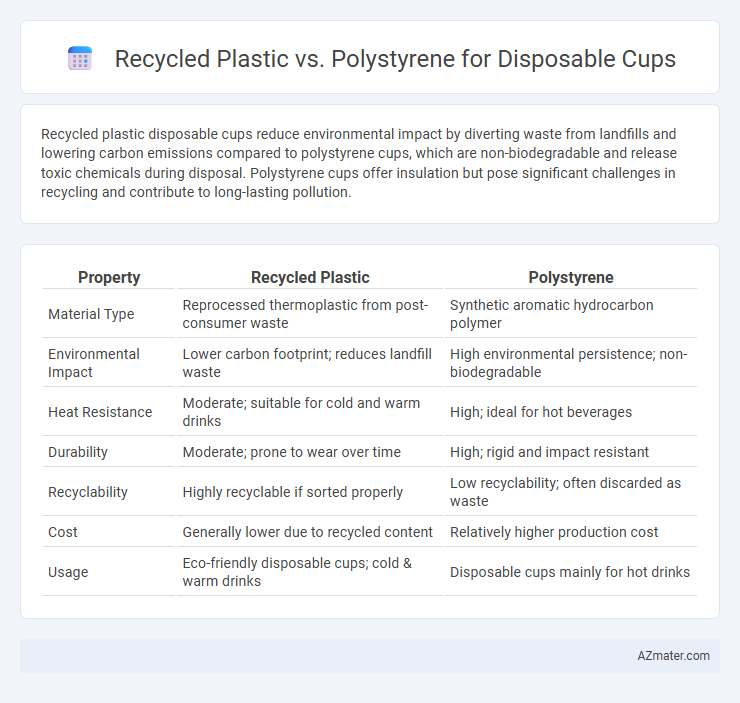Recycled plastic disposable cups reduce environmental impact by diverting waste from landfills and lowering carbon emissions compared to polystyrene cups, which are non-biodegradable and release toxic chemicals during disposal. Polystyrene cups offer insulation but pose significant challenges in recycling and contribute to long-lasting pollution.
Table of Comparison
| Property | Recycled Plastic | Polystyrene |
|---|---|---|
| Material Type | Reprocessed thermoplastic from post-consumer waste | Synthetic aromatic hydrocarbon polymer |
| Environmental Impact | Lower carbon footprint; reduces landfill waste | High environmental persistence; non-biodegradable |
| Heat Resistance | Moderate; suitable for cold and warm drinks | High; ideal for hot beverages |
| Durability | Moderate; prone to wear over time | High; rigid and impact resistant |
| Recyclability | Highly recyclable if sorted properly | Low recyclability; often discarded as waste |
| Cost | Generally lower due to recycled content | Relatively higher production cost |
| Usage | Eco-friendly disposable cups; cold & warm drinks | Disposable cups mainly for hot drinks |
Introduction to Disposable Cup Materials
Recycled plastic and polystyrene are common materials used for disposable cups, each with distinct environmental impacts and performance characteristics. Recycled plastic cups reduce waste by repurposing materials like PET, contributing to lower carbon footprints and enhanced sustainability. Polystyrene cups offer insulation and low cost but pose challenges due to poor biodegradability and recycling difficulties, making recycled plastic a more eco-friendly choice in disposable cup manufacturing.
Overview of Recycled Plastic in Disposable Cups
Recycled plastic used in disposable cups primarily comes from post-consumer PET (polyethylene terephthalate) bottles, offering a sustainable alternative to virgin plastic and reducing landfill waste. These cups retain similar durability and thermal properties compared to polystyrene, while significantly lowering carbon footprints and energy consumption during production. Innovations in recycling technologies enhance the clarity and safety of recycled plastic cups, making them increasingly viable for food and beverage applications.
Understanding Polystyrene as a Cup Material
Polystyrene is a lightweight, inexpensive plastic commonly used for disposable cups due to its excellent insulation properties and rigidity. Unlike recycled plastics, polystyrene is a petroleum-based polymer that is less environmentally friendly because it is non-biodegradable and challenging to recycle. Its widespread use in single-use cups results in significant environmental concerns, making sustainable alternatives like recycled plastics preferable for reducing plastic waste.
Environmental Impact: Recycled Plastic vs Polystyrene
Recycled plastic disposable cups significantly reduce environmental impact by diverting waste from landfills and lowering the demand for virgin plastic production, which decreases carbon emissions and energy consumption. Polystyrene cups, while lightweight and inexpensive, are non-biodegradable, contribute heavily to landfill volume, and often break into microplastics, posing long-term ecological hazards. Compared to polystyrene, recycled plastic materials offer improved sustainability through reuse of post-consumer waste and enhanced recyclability in waste management systems.
Manufacturing Processes and Energy Consumption
Recycled plastic cups typically undergo a melting and reshaping process that consumes less energy compared to the polymerization and molding stages required for polystyrene cups. Manufacturing recycled plastic involves lower greenhouse gas emissions due to the reuse of existing materials, whereas polystyrene production relies heavily on petroleum-based raw materials and energy-intensive expansion processes. Energy consumption for recycled plastic cup production ranges from 30% to 50% less than conventional polystyrene, making it a more sustainable option in disposable cup manufacturing.
Safety and Chemical Leaching Concerns
Recycled plastic disposable cups often pose lower chemical leaching risks compared to polystyrene, which can release styrene, a probable human carcinogen, especially when exposed to heat. Polystyrene cups are more prone to chemical migration into beverages, raising health safety concerns in food and drink applications. Using BPA-free recycled plastics with proper food-grade certifications minimizes toxic exposure and enhances consumer safety in disposable cup usage.
Cost Comparison: Recycled Plastic vs Polystyrene
Recycled plastic disposable cups generally cost more upfront than polystyrene cups due to higher processing expenses and sourcing challenges for sustainable materials. Polystyrene cups remain cheaper to produce at scale, benefiting from established manufacturing infrastructure and abundant raw materials. Over time, recycled plastic cups may offset costs through environmental benefits and potential regulatory incentives that increase polystyrene compliance expenses.
Consumer Perception and Market Trends
Consumer perception favors recycled plastic disposable cups due to growing environmental awareness and demand for sustainable products, whereas polystyrene cups face criticism for their non-biodegradability and contribution to plastic pollution. Market trends show an increasing shift towards recycled plastic cups driven by regulatory bans on single-use polystyrene in several countries and rising corporate commitments to eco-friendly packaging. The preference for recycled plastic aligns with circular economy principles, reinforcing its competitive advantage over polystyrene in the disposable cup industry.
Recycling and End-of-Life Management
Recycled plastic disposable cups offer enhanced recyclability compared to polystyrene, as they can be reprocessed into new products with fewer contaminants, reducing landfill waste significantly. Polystyrene cups, although lightweight, are challenging to recycle due to their low density and contamination issues, often leading to incineration or landfill disposal, which raises environmental concerns. Effective end-of-life management prioritizes recycled plastics for circular economy integration, promoting reduced carbon footprint and resource conservation over the limited recyclability of polystyrene materials.
Conclusion: Which Material is More Sustainable?
Recycled plastic offers a more sustainable option for disposable cups due to its reduced reliance on virgin resources and lower carbon footprint compared to polystyrene. Polystyrene, while lightweight and insulating, is less biodegradable and often contributes to long-lasting environmental pollution. Prioritizing recycled plastic in cup production supports circular economy principles and decreases landfill waste, making it the preferred eco-friendly choice.

Infographic: Recycled plastic vs Polystyrene for Disposable cup
 azmater.com
azmater.com